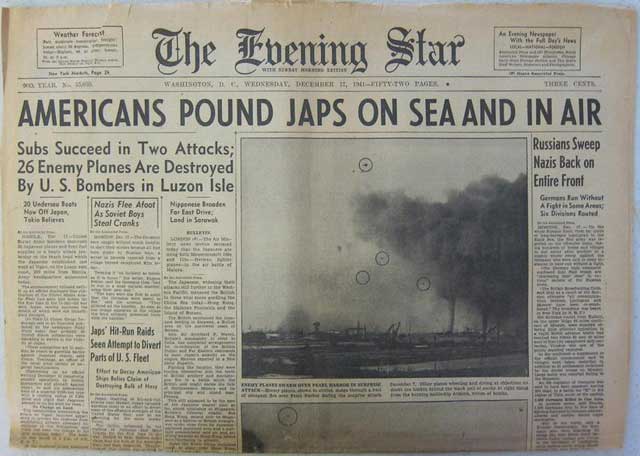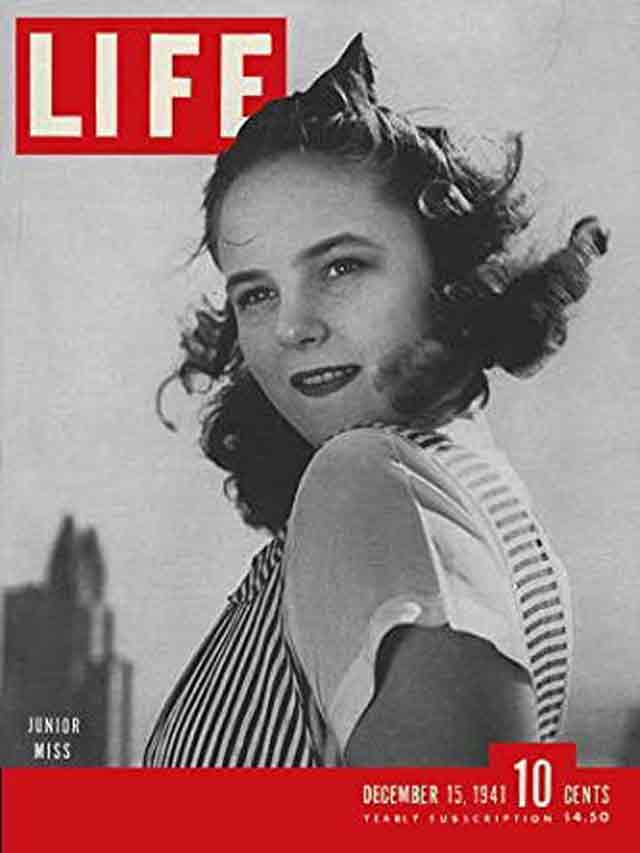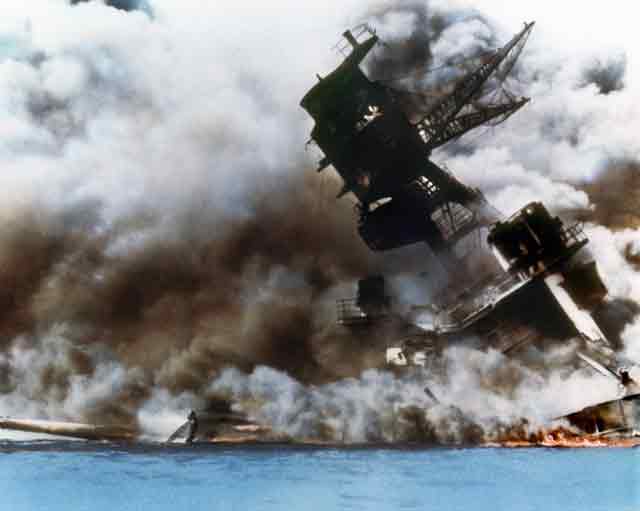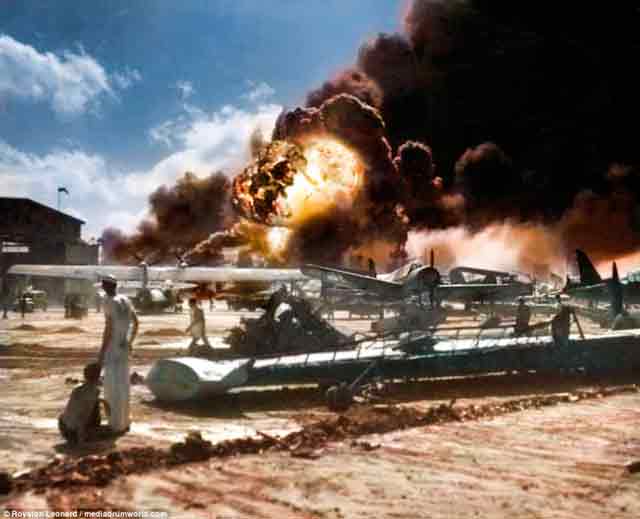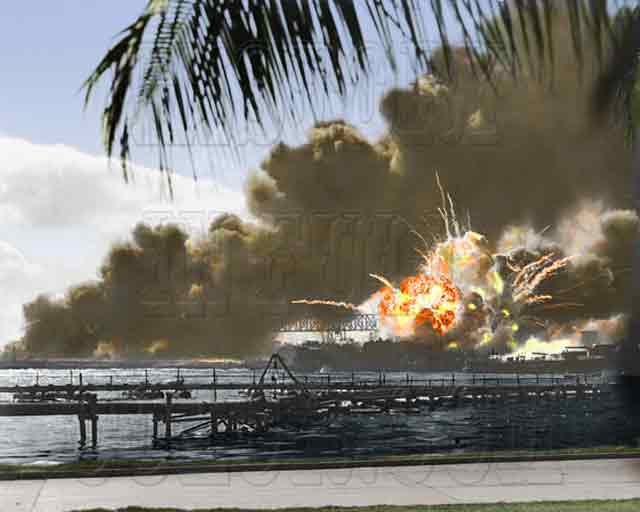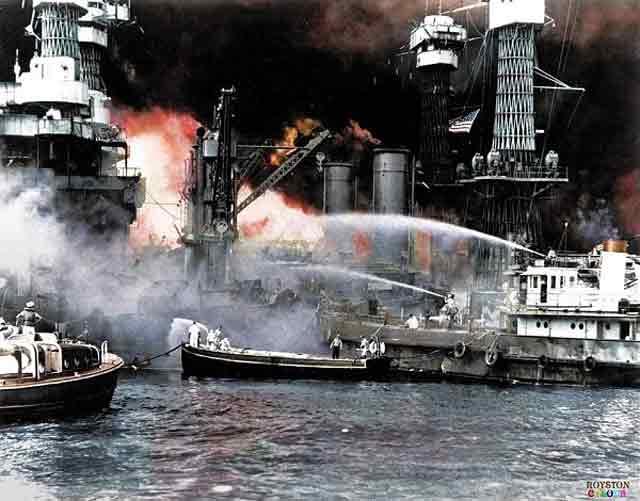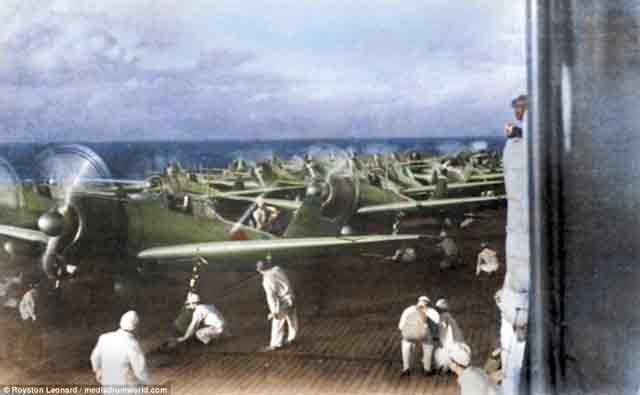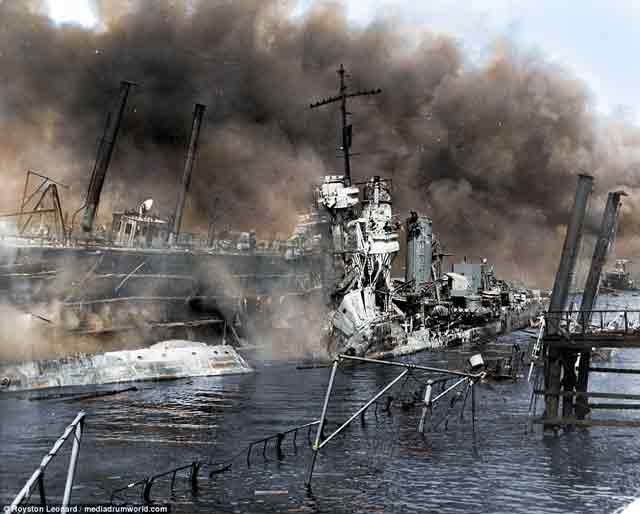Sunday 7 December 1941
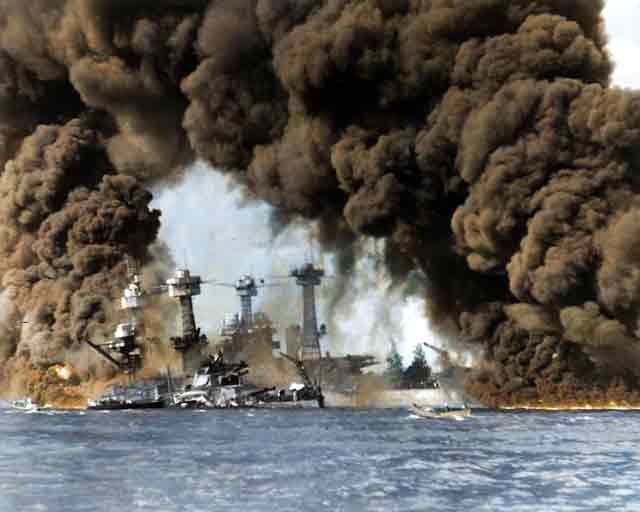 |
| The attack on Pearl Harbor, 7 December 1941. The images on here are colorized enhanced of classic black-and-white original photos of the attack on Pearl Harbor. |
The events of
7 December 1941 make it one of the most pivotal in world history. This site has detailed on a day-by-day basis the decisions which led to the horrors which erupt today, but what happens on 7 December 1941 itself encapsulates and even exceeds the drama of all the leading up to it. This page will attempt to give a chronological review of the decisions and reactions around the globe. I am indebted to Stanley Weintraub's "Long Day's Journey Into War: December 7, 1941" (Dutton 1991), which I have had beside me to help keep the different time zones straight. All errors herein, however, are my own, of course.
For purposes of this summary, we disregard the fact that it is December 8 in certain places (and even still 6 December in a few): the day presented here begins and ends with Hawaiian local time. The headings refer to the events that happen during the hour
after the time shown. For another view of the events surrounding the Pearl Harbor attack and more pictures, or if this chronological approach is not to your taste, I discuss the Japanese attack of 7 December 1941 much more thematically
here.
Hawaii Midnight: It is 1:00 p.m. on the Eastern Front. South of Moscow, General Heinz Guderian is pulling his Second Panzer Army back to the west as fast as he can following the surprise Red Army counteroffensive that began on 5 December 1941. Guderian confers with Luftwaffe General Lothar Freiherr von Richthofen (Manfred von Richthofen, the Red Baron of World War I fame, is his cousin) and General Rudolf Schmidt, commander of Second Army on Guderian's left flank. They all agree that a quick retreat is the only option.
It is noon at the Wolfsschanze ("Wolf's Lair"), Adolf Hitler's headquarters in East Prussia, where Hitler is conducting his usual mid-day strategy conference. Army commander Field Marshal Walther von Brauchitsch has been in contact with Field Marshal von Bock at Army Group Center and knows a retreat is necessary, but he cannot bring himself to contradict the Fuehrer. So, instead, he asks to be relieved for reasons of ill health (he recently had a heart attack). General Keitel suggests at least halting offensive operations in order to rest and refit, but Hitler shouts him down. Field Marshal Ritter von Leeb calls from his headquarters at Army Group South and warns that his advanced position at Tikhvin is "very tight." General Halder, OKH chief of operations, notes in his daily summary that von Leeb:
thinks [he] cannot hold Tikhvin and is preparing to return to a defensive position... In the Ladoga sector, enemy reinforcements have apparently been arriving from across the lake. Violent attacks at Leningrad.
In Tokyo, it now is 6 p.m. on 7 December 1941. The Japanese Foreign Ministry finally finishes sending the 14-part "final notice" (
Saigo Tsūchi) via Mackay Radio and RCA (two separate copies) to the embassy in Washington. At 6:30 p.m., another message is sent with corrections and instructions for delivery.
Off Khota Bharu, Malaysia, a patrolling RAAF Hudson bomber spots the Japanese transport ships that have sailed south from Hainan and Saigon about 65 miles offshore. Japanese destroyer Uranami, which stopped Norwegian freighter Halldor on the 6th and destroyed that ship's radio, opens fire on the Hudson (pilot RAAF Flight Lieutenant John Lockwood), which may be the first shots fired in anger in this phase of the conflict. Another Australian Hudson is vectored in and confirms the sighting half an hour later. The information is passed on to Singapore commander Sir Henry Brooke-Popham.
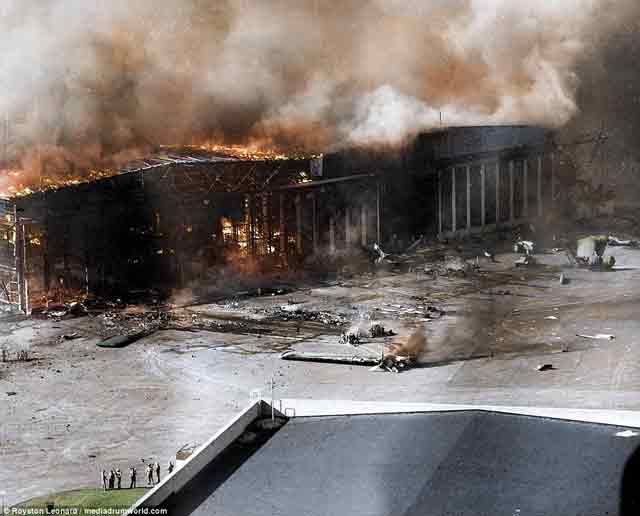 |
| The Ford Island aircraft hanger burning. |
Hawaii 1 a.m.: In the Philippines, US Radio Intelligence at Fort McKinley begins picking up a sudden stream of around 25-30 brief messages being sent from Tokyo to diplomatic posts around the world. There also are reports of Japanese planes flying over the Philippines, which puts everyone on edge. When decoded, the messages appear innocuous, but a sudden burst of such traffic is always worthy of notice.
Hawaii 2 a.m.: Japanese Ambassador to Thailand Teiji Tsugami calls on the Thai Foreign Minister, Chaiyanam Direk, in Bangkok at about 7:30 p.m. Tsugami tells Direk that Japan is about to declare war on Great Britain and the United States - apparently the first time that Japan officially tips its hand - and requests the right of free passage from Cambodia through Thailand to the Burmese and Malayan borders. Direk replies that he will have to consult with his government, but he knows that Field Marshal Phibun, the premier, has made it clear that no infringement of Thai territory was to be tolerated. The Thai police chief and deputy premier, Detcharat Adun, also attends the meeting and quickly gets a message to Phibun. He also calls an emergency cabinet meeting for the next morning.
It is noontime in England. US Ambassador John Gilbert Winant visits Winston Churchill at Chequers, Churchill's country home. Churchill asks Winant his opinion on whether Japan will attack, to which Winant replies in the affirmative. Churchill says:
If they attack you, we will declare war. If they attack us, you declare war.
Winant agrees with the sentiment but replies that he cannot guarantee anything since only Congress can declare war.
Hawaii 3 a.m.: In Tokyo at 10:30 p.m., US Ambassador Joseph Grew receives a "final appeal" drafted by President Roosevelt and sent by US Secretary of State Cordell Hull for delivery to the Japanese government. The message has been held up for ten hours by the Japanese military in order to forestall any last-minute attempts to prevent the outbreak of war. Grew's staff immediately contacts Japanese Foreign Minister Togo's staff to set up an immediate meeting, but are told to call back the next morning. Togo, of course, knows exactly when the attacks are due to begin. However, Grew's staff persists due to the extreme urgency of the situation, and Togo finally agrees to see Grew if he can come over by midnight. Grew's staff works frantically to decode the message from Roosevelt to get it ready within an hour.
In Washington at about 8 a.m., Japanese Embassy official Katsuzo Okamura is furiously typing up the final Japanese message for delivery to Secretary of State Cordell Hull. The embassy suddenly receives another section of the very long Japanese statement that is delivered by commercial telegraph. This is the critical final paragraph of the diplomatic note. The instructions sent earlier by Tokyo to deliver the message at exactly 1:00 p.m. also arrives, along with the corrections - which require previous pages to be retyped. Okamura keeps working as fast as he can, he is the only embassy employee with security clearance who knows how to use an American typewriter.
At the US Navy Department in Washington, Naval Intelligence receives the final section of the Japanese message perhaps even before the Japanese Embassy does. The analysts immediately decode it to quickly find that it concludes that "it is impossible to reach an agreement through further negotiations." This certainly is ominous, but it is not a declaration of war. It is delivered immediately to Admiral Stark and a few others, who surmise that it means war is imminent.
Joint Chiefs of Staff Chairman General George C. Marshall leaves for his usual Sunday morning horseback. It is on a farm that one day will become the site of the Pentagon.
In Manila at 9:45 p.m., Major General Lewis H. Brereton attends a party at the Manila Hotel. He writes in his diary that he meets Rear Admiral William Purnell, Admiral Thomas Hart's chief of staff, who confides that Washington has issued a secret war alert and that the Japanese could attack within hours.
In Cairo, Egypt, it is mid-afternoon. RAF Air Chief Marshal Sir Arthur Tedder runs into US Colonel Bonner Fellers, who is an "observer." As Fellers recalls over 25 years later, Tedder strangely tells him:
Bonner, you will be in the war in twenty-four hours. We have had a secret signal [that] Japan will strike the U.S. in twenty-four hours.
Fellers assumes that if the British know this, they have informed Washington. After all, they are pretty much allies. So, Fellers doesn't mention this odd comment to anyone at the time. But whatever source of information Tedder has been privy to (perhaps Ultra) has not been shared with the Americans. Unfortunately, Fellers is never able to provide any corroboration to support this incident.
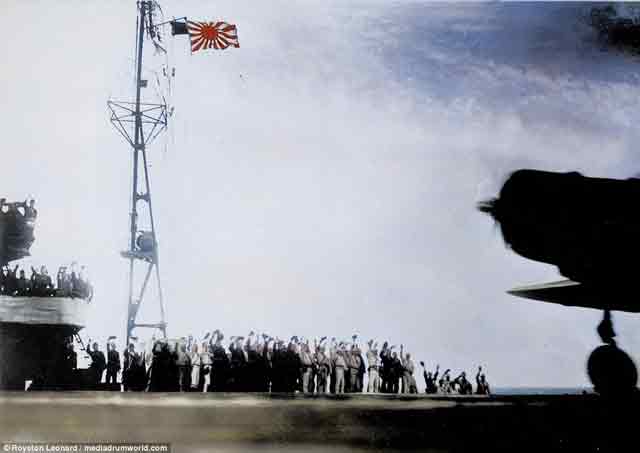 |
| The planes depart the Japanese aircraft carriers to shouts of "Banzai." |
British Foreign Secretary Anthony Eden boards a train in London at 1:00 p.m. with Soviet Ambassador Ivan Maisky which will take them north to the Royal Navy base at Scapa Flow. There, they will board a cruiser for a trip to Murmansk.
At 3:42 a.m., the destroyer USS Ward and minesweepers Crosshill and Condor are on patrol when they spot a suspicious object in the water near Pearl Harbor. Condor sends a semaphore message to Ward saying, "Sighted submerged submarine on westerly course speed 9 knots." The Ward starts a sonar search, but after 45 minutes finds nothing and gives up the search. Neither the Condor nor the Ward decides to report the incident, and while later communications between the ships are picked up by a Navy monitoring station at Bishop's Point, they don't inform their superiors about the sighting either.
Hawaii 4 a.m.: Officials in Washington continue to analyze the decoded Japanese "final message." They decide that nothing will happen until the note is delivered by the Japanese ambassador. The instructions to Ambassador Nomura to deliver the note at 1:00 p.m. are interpreted as meaning nothing will happen before then. General Marshall's staff goes looking for him.
Ambassador Grew in Tokyo arrives at Foreign Minister Togo's residence at 11:50 p.m., just beating the midnight deadline. He has President Roosevelt's "final plea." Grew asks for permission to deliver the message to Emperor Hirohito immediately. Togo says it is too late for an imperial audience, so Grew reads Togo the message. After this, Togo promises to arrange a meeting with the Emperor and ushers Grew out.
General Marshall returns from his morning ride and gets a message to call his office. Over the insecure phone, Marshall learns that a new and apparently important Japanese message has arrived and been decoded. He immediately has his driver take him into his office using one of his family cars, meeting the official staff coming out from Washington on the way.
In Singapore, Brooke-Popham and General Arthur Percival, officer commanding (Malaya), meet and discuss the Hudson sightings of the Japanese invasion fleet and other military intelligence. They decide that it is unwise to implement Operation Matador, the standard defensive plan wherein British troops advance north from Singapore and take up defensive positions on the peninsula. They inform Whitehall in a cable that "Japanese movements are consistent with a deliberate attempt to induce us to violate Thai neutrality." They agree to do nothing and wait to see what develops.
Hawaii 5 a.m.: While USS Condor's skipper decides to return to port at 5:08 a.m., USS Ward continues its search outside Pearl Harbor for the mysterious submerged submarine. The harbor is protected by anti-submarine nets, which open to allow Condor back into the harbor. Because other traffic is expected to leave port soon, the gate operators simply leave the port gate open rather than bother closing it and re-opening it repeatedly. The gate does not close again until 8:46 a.m.
Kido Butai, the Japanese main carrier strike force heading for Hawaii, has reached its attack position about 200 miles north of Pearl Harbor. At 5:30 a.m., Cruisers Tone and Chikuma launch reconnaissance floatplanes which are to fly over the Hawaiian islands, the Tone's plane over Lahaina Roads on Maui, the Chikuma's to keep an eye on Pearl Harbor itself. This proves to be a hazardous flight for the two pilots - not because of the Americans, but because some of the other Japanese ships temporarily mistake them for US scout planes.
 |
| The USS West Virginia (foreground) and the USS Tennessee. |
Hawaii 6 a.m.: In Washington, Ambassador Nomura receives the decrypted cable that provides instructions on when to deliver the 14-part message to Secretary of State Cordell Hull. He realizes for the first time that it must be done at 1 p.m., which is in only two hours. Katsuzo Okamura continues typing and retyping, struggling to get a clean copy suitable for such an auspicious occasion.
Secretary Hull already knows all about the Japanese diplomatic note even though he won't receive it for at least another two hours. He confers with Secretaries Stimson and Knox, and everyone agrees that the Japanese are planning something big. As Secretary Stimson jots down during the meeting:
Hull is very certain that the Jap[anese] are planning some deviltry and we are all wondering where the blow will strike.
They don't expect the Japanese to attack the United States, but Stimson notes that "We three all thought that we must fight if the British fought."
At Sembawang Aerodrome in north Singapore, the operations room issues instructions to the duty pilot, W.R. Halliday of RAF No. 453 Squadron, to turn off all aerodrome lights because of the possibility of enemy action. This is unusual, but Halliday does not question orders and simply complies. Halliday does try calling his fellow pilots' barracks to alert them that something is up, but nobody answers the phone, he can't leave his station, and there is nobody else around to carry a message. There is nothing that he can do, and nobody else thinks to wake up the sleeping men.
Thai Premier Luang Phibun, who is out of town, sends a message to Deputy Premier Detcharat Adun telling him that he would be returning from his trip by car (he refuses Adun's offer of a plane) and will be there by dawn. Adun meets with the cabinet and everyone agrees, in Phibun's absence, that the only proper course of action is to simply allow the Japanese forces a right of transit through Thai territory. The meeting adjourns without any final decision or vote, but doing nothing is the same as granting Japanese troops free access to Thai territory. Some think that Phibun refuses to return from his little troop sooner - which he easily could do by plane - precisely because this is the outcome that he wants.

Southeast of Leningrad, the German commander of 38th Army Corps, Friedrich-Wilhelm von Chappuis, gives orders to evacuate Tikhvin. The city is exposed to assault from three sides and the supply corridor has been under crumbling. The Spanish Blue Division guarding one of the flanks already is retreating under heavy pressure, and other troops likely are as well. The order to the corps is to retreat behind the Volkhov River. This is done with alacrity. Evacuating Tikhvin reopens for the Soviets their best rail and truck supply routes from Moscow to Leningrad via Lake Ladoga.
Japanese Foreign Minister Togo meets briefly with Prime Minister Tojo at the latter's home. After learning that there are no concessions in President Roosevelt's "final appeal," Tojo says that this is insufficient, but that Ambassador could visit the Emperor if he wished. Tojo then prepares a formal statement for Emperor Hirohito to hand to Ambassador Grew when they meet.
Off Kota Bharu, the Japanese invasion fleet drops anchor at 11:55 p.m. Bangkok time. The troops begin boarding landing craft.
The aircraft carrier
USS Enterprise, returning from Wake Island, launches 18 Dauntless SBDs to scout ahead of the ship, which is 215 miles west of Pearl Harbor, and land at Ford Island. The ship is maintaining radio silence, and sending the planes to land at Pearl Harbor will be a good way for Admiral "Bull" Halsey to tell the naval commanders there that the Enterprise is running a little late due to heavy seas and engine trouble by destroyer USS Dunlap and won't make port until Monday afternoon.
USS Antares, a Navy supply ship, spots something half-submerged in the water. He notes that it is a submarine that is having "depth-control problems." A PBY patrol plane also spots the object. Both report their sightings to the Ward. The Ward also opens fire with its main guns. A shell from Ward's number three gun sinks the sub. Ward then begins dropping depth charges to make sure of the sinking, with the PBY also dropping some. At 6:53 a.m., Captain Outerbridge aboard the Ward radios the 14th Naval District Headquarters:
We have attacked fired upon and dropped depth charges upon submarine operating in defensive sea area.
Headquarters does not issue any alarms about this.
North of Oahu, the six Japanese fleet carriers turn into the wind in order to launch their planes. Despite rough seas, the first strike force of 182 fighters and bombers is in the air by 6:15 a.m., just as dawn is beginning to break. For the pilots, it is just past bedtime because they are still maintaining Tokyo time. The planes head south toward Pearl Harbor, 230 miles away.
Hawaii 7 a.m.: In Washington, the Japanese official typing up the "final notice" for delivery to Secretary of State Cordell Hull receives the critical last section at 12:30. Ambassador Nomura telephones Secretary Hull and tells him that he will be late for their 1:00 p.m. meeting. Hull graciously replies that he will make himself available whenever Nomura is ready.
While four of five mobile radar units on Oahu shut down at 7 a.m. as scheduled, one at Opana remains open longer to get in some extra practice. They have reported a small blip, which is one of the floatplanes launched ahead of the attack force, but the men at Fort Shafter have not inquired further about it. At 7:02, the man at the screen, Private Elliott, notices "something completely out of the ordinary." It is a large blip about 137 miles north of the island. Private Lockard telephones Fort Shafter again. Nobody is around to take the call, but Lieutenant Kermit A. Tyler calls back a few minutes later. Tyler is a fighter pilot in the 78th Pursuit Squadron. After Lockard describes the sighting, Tyler assumes that it is a flight of B-17s expected in that morning from California and tells Lockard "don't worry about it."
The Japanese landing forces in Malaya land at their targets on the Kra Isthmus. The British receive their first reports of landings, and General Percival calls Governor Sir Shenton Thomas with the news. Thomas immediately orders police to begin rounding up all Japanese adult males in Singapore. The Japanese rapidly occupy Kota Bharu, about 400 miles north of Singapore.
After sinking the submarine, USS Ward spots a suspicious boat in the defensive zone outside the harbor. Commander Outerbridge radios headquarters:
We are escorting this sampan into Honolulu. Please inform Coast Guard to send cutter [to] relieve us of sampan.
Outerbridge notes that the crew of the sampan waves white surrender flags for some reason. On the way back to Pearl, the Ward spots another suspicious object and drops some more depth charges. It is another Japanese submarine, though the Ward never makes a positive identification. Ensign Sakamoto, in charge of the small craft, is rattled but the submarine is undamaged. He turns the submarine out of harm's way and prepares to watch the show.
Tone's floatplane over Maui sends a message back to the Japanese fleet at 7:38:
The enemy fleet is not at Lahaina anchorage.
The Chikuma's floatplane then sends a message:
Cloud ceiling over the enemy fleet, 1700 meters. Its density, scale 7. 0308.
The "0308" at the end of the message indicates the time sent in the Tokyo time under which the fleet is operating. The floatplane's pilot then reports that the United States fleet is in Pearl Harbor as expected.
Admiral Husband Kimmel, commander at Pearl Harbor, hears of destroyer Ward's submarine encounter at 7:40 a.m. He tells his staff duty officer, "I'll be right down."
At 7:48 a.m., the Japanese planes bearing in from the north split up into groups. One group makes landfall near Kaneohe and begins shooting up the 36 PBYs of Patrol Wing One. The headquarters there telephones Bellows Field to warn them, but the duty officer dismisses the report. Another group attacks a Marine base at Ewa, quickly destroying 33 planes on the ground and disabling the remaining 14 others.
Fifty-three Japanese planes arrive over Pearl Harbor at 07:49 a.m., and Commander Mitsuo Fuchida, flying in a non-combatant observation plane, radios "To-To-To," which is his unofficial signal to begin the attack. This message is picked up all the way off in Tokyo. Fuchida spends the mission monitoring the results and taking pictures.
The first bombs dropping at 7:53. Fuchida then radios "Tora Tora Tora," which is his signal for a successful attack. This is picked up on the Akagi, where Admiral Nagumo hears it and shakes hands with another officer. This message also is picked up by the battleship Nagano anchored in the Inland Sea near Hiroshima, where Admiral Yamamoto and his crew celebrate.
In Tokyo, Foreign Minister Togo meets with Emperor Hirohito. Togo reads President Roosevelt's note. Hirohito approves the reply to Ambassador Grew that Tojo has prepared for him. Togo then leaves, and as soon as he gets home he receives confirmation that the attack on Pearl Harbor is in progress.
At 7:58 a.m., Rear Admiral Patrick Bellinger, Pacific Air Arm commander, tells a radio operator on Ford Island to send out a brief alert to the Mare Island Naval Station Bay:
Air Raid Pearl Harbor. This is no drill.
The message is picked up by many other stations, including at Naval Communications in Washington. The message is notable for its failure to identify who is conducting this air raid - but everyone can figure that out.
Hawaii 8 a.m.: Per standard procedure, Naval Communications in Washington forwards the message from Ford Island to Rear Admiral Leigh Noyes. Noyes rushes over to Secretary of the Navy Frank Knox with the news right around 1:30 p.m. (which is the same time as 8 a.m. in Hawaii. Admiral Harold Stark, Chief of Naval Operations, is nearby and learns the news from Knox. Colonel John R. Deane tracks down General Marshall at lunch and calls him with the news. Quickly, other messages from Hawaii confirming the first one arrive.
FBI Honolulu branch chief Robert L. Shivers calls J. Edgar Hoover in New York City. When Hoover expresses disbelief, Shivers says:
I know Japanese airplanes when I see them. You can hear the bombs yourself! Listen!
And Shivers held out the telephone so it could pick up the sounds of the explosions.
At 8:04, KGMB in Honolulu interrupts its regular programming with a call for all military personnel to report to their units immediately. However, no news of the reason for the call-up is given. Admiral Kimmel watches the attack from his office overlooking Pearl Harbor and is struck in the chest by a spent bullet. He comments wryly, "It would have been merciful had it killed me."
The flight of B-17 bombers flying in from California arrives during the Japanese air raid. They are unarmed and nearly out of fuel. Confused U.S. anti-aircraft gunners target the B-17s as they appear over Pearl Harbor. A couple land at Haleiwa, while one crash-lands at Hickam after being hit by a Zero. One of the crewmen on the Hickam plane is strafed on the runway as he runs for cover. The rest of the B-17s land wherever they can, including one on the Kahuku Golf Course.
A few US fighter pilots make it into the air. Two pilots drive from Wheeler to Haleiwa and take off in their P-40s. The Enterprise's SBD Dauntlesses arrive during the battle, and the Japanese fighters shoot six of the planes down while they shoot down one Zero. Of the 404 US aircraft at Hawaii, 188 are destroyed and 159 damaged.
In the Philippines, there is still no news of the Pearl Harbor attack. A radar detects a strange blip approaching from Formosa. The radar operator telephones Colonel Harold George, chief of Interceptor Command. George immediately orders P-40 fighters into the air from Iba Field. However, the fighters do not spot any intruders, so George sends up another flight - which also spots nothing.
Secretary Knox finally remembers to call President Roosevelt with news of the attack at 1:47 p.m., seventeen minutes after he learns of the raid:
Mr. President, it looks as if the Japanese have attacked Pearl Harbor.
Roosevelt comments to Harry Hopkins, who is there having lunch, "At the time they were discussing peace in the Pacific, they were planning to overthrow it."
The Japanese Embassy staff finally finishes typing up the Japanese note to President Roosevelt at 1:50 p.m. Ambassador Nomura immediately drives over to Secretary Hull's office.
The second wave of Japanese planes, 171 in all, crosses Kahuku Point on Oahu. They head straight for Pearl Harbor, easily identifiable from the smoke arising from burning ships. The torpedo bombers focus on ships sending up the most anti-aircraft fire, the pilots figuring these are the least damaged. This attack targets cruisers and even destroyers in addition to battleship row. A total of 354 planes take part in the two waves.
Hawaii 9:00 a.m.: In the Manila Hotel in the Philippines, the Marine duty officer at naval headquarters reaches Admiral Hart by telephone, reading him the initial message from Pearl Harbor. Hart sends a general alert out to all stations almost immediately. General Richard Sutherland, Douglas MacArthur's chief of staff, reaches MacArthur by telephone and informs him of the attack. Brigadier General Gerow in Washington then calls MacArthur and fills him in on some details, warning, "I wouldn't be surprised if you get an attack there in the near future."
At 9:21 a.m., CINCPAC sends Task Forces 3, 8, and 12 orders to rendezvous and await further instructions "when the enemy is located." Onboard the Enterprise, Admiral Halsey orders four fighters into the air to try and find the Japanese fleet. The rendezvous point is about 120 miles west of Kauai, far from the Japanese fleet north of Oahu.
Incidentally, to answer the common question, "where were the US Navy aircraft carriers during the attack on Pearl Harbor," here is the answer: There was not a single US aircraft carrier at Pearl Harbor at any time on 7 December 1941. This was for routine reasons and not due to any "plan" to have them avoid the attack. Let's summarize where they all are on 7 December 1941.
Admiral "Bull" Halsey is returning from Wake Island aboard USS Enterprise (Task Force 8) but is late in returning due to rough seas (but for that random event, the Enterprise might have been entering Pearl Harbor during the attack). Although still about a day’s sail away to the west, Halsey ultimately launches 18 Dauntless SBDs to search for the Japanese fleet on 7 December 1941. The US Enterprise is the only carrier with any remote possibility of intervening in the events of 7 December 1941 but the Enterprise is in the wrong position relative to the Japanese fleet and has virtually no chance of finding the Japanese ships unless somehow directed to them. This does not happen because the only people who know where the Japanese ships are, are the Japanese themselves. The planes find nothing and there are no radar contacts (aside from the famous pre-attack readings on Oahu that were mistaken for expected US planes and are never properly interpreted until long after the events in question).
USS Lexington (TF-12) is proceeding on a similar ferrying mission to Midway Island and is several days' sail away from Hawaii. It immediately aborts the mission without sending off its planes and returns to Pearl Harbor. USS Lexington does not arrive at Pearl until days later when "the coast is clear."
USS Saratoga is en route to San Diego after repairs in Puget Sound Navy Yard, Bremerton, Washington. It is very close to the port there and proceeds there as ordered after the Pearl Harbor attack. and is nowhere near Pearl Harbor at any time on 7 December 1941. At the end of the day, it is anchored in the San Diego harbor.
USS Yorktown, Ranger, Wasp, and Long Island (a brand new escort carrier) are all in the Atlantic assisting with Neutrality Patrols. USS Hornet is brand new and does not yet carry any planes so it would be useless even if it were at Pearl Harbor, which it is not (fortunately for it and its crew). In fact, it is anchored off Norfolk, Virginia.
That accounts for all US Navy aircraft carriers in service on 7 December 1941. Halsey’s search planes don't find the Japanese ships because nobody knows where the attacking planes are coming from (a little over 200 miles north of the islands) and the Japanese carriers are beyond the search range of the Enterprises's planes. There are erroneous reports that the Japanese planes came from the south (reports based on mistaking US Navy ships for Japanese ones). Halsey's planes patrol to the west of Pearl Harbor due to the Enterprise's own location. There is utter confusion on the US side, everyone is operating in the dark, and expecting some kind of perfect response is unrealistic.
Hawaii 10:00 a.m.: German official news agency DNB carries news of the Japanese attack on Pearl Harbor at about 10:30 p.m. At the Wolfsschanze, Hitler is holding court with his cronies before his usual midnight war conference. He is elated to hear news of the attack, saying:
Now it is impossible for us to lose the war: we now have an ally who has never been vanquished in three thousand years, and ally who has constantly been vanquished but has always ended up on the right side.
Hitler shows general positive emotion, a rarity at his military headquarters. He even calls for champagne and stages a unique party for ordinary headquarters staff, even having a few glasses himself. It is a welcome moment of happiness during a very gloomy winter.
President Roosevelt convenes a cabinet meeting in the Oval Office at 3:00 p.m. News from Hawaii is still very sketchy, and Roosevelt personally takes telephone calls during the meeting. He vows to submit a "precise message" to Congress in his call for a declaration of war.
 |
| USS Oklahoma's keel, right, is visible after it was hit by five torpedoes. |
Hawaii 12 noon: The planes from the first two Japanese attack waves have returned and been refueled and rearmed. There is great enthusiasm throughout the Japanese fleet for a third strike. The pilots have reported many valuable targets remaining to be destroyed at Pearl Harbor, including the massive fuel storage tanks clustered near the harbor. Admiral Nagumo gives it a lot of thought and is pleased with the results of the first two strikes. However, there are good arguments to be made for leaving with the victory intact, including the unknown location of the US Navy aircraft carriers. If the planes were all sent to attack Pearl Harbor again, that would leave the fleet defenseless against a possible reprisal raid. The argument rages for a while, and then finally Nagumo decides to withdraw. The attack on Pearl Harbor is over.
December 1941December 1, 1941: Hitler Fires von RundstedtDecember 2, 1941: Climb Mount NiitakaDecember 3, 1941: Hints of Trouble in the PacificDecember 4, 1941: Soviets Plan CounteroffensiveDecember 5, 1941: Soviets Counterattack at KalininDecember 6, 1941: Soviet Counterattack at Moscow BroadensDecember 7, 1941: Japan Attacks Pearl HarborDecember 8, 1941: US Enters World War IIDecember 9, 1941: German Retreat At MoscowDecember 10, 1941: HMS Prince of Wales and Repulse SunkDecember 11, 1941: Hitler Declares War on USDecember 12, 1941: Japanese in BurmaDecember 13, 1941: Battle of Cape BonDecember 14, 1941: Hitler Forbids WithdrawalsDecember 15, 1941: The Liepaja MassacreDecember 16, 1941: Japan Invades BorneoDecember 17, 1941: US Military ShakeupDecember 18, 1941: Hitler Lays Down the LawDecember 19, 1941: Brauchitsch Goes HomeDecember 20, 1941: Flying Tigers in ActionDecember 21, 1941: The Bogdanovka MassacreDecember 22, 1941: Major Japanese Landings North of ManilaDecember 23, 1941: Wake Island Falls to JapanDecember 24, 1941: Atrocities in Hong KongDecember 25, 1941: Japan Takes Hong KongDecember 26, 1941: Soviets Land in the CrimeaDecember 27, 1941: Commandos Raid NorwayDecember 28, 1941: Operation Anthropoid BeginsDecember 29, 1941: Soviet Landings at FeodosiaDecember 30, 1941: Race for BataanDecember 31, 1941: Nimitz in Charge2020




















